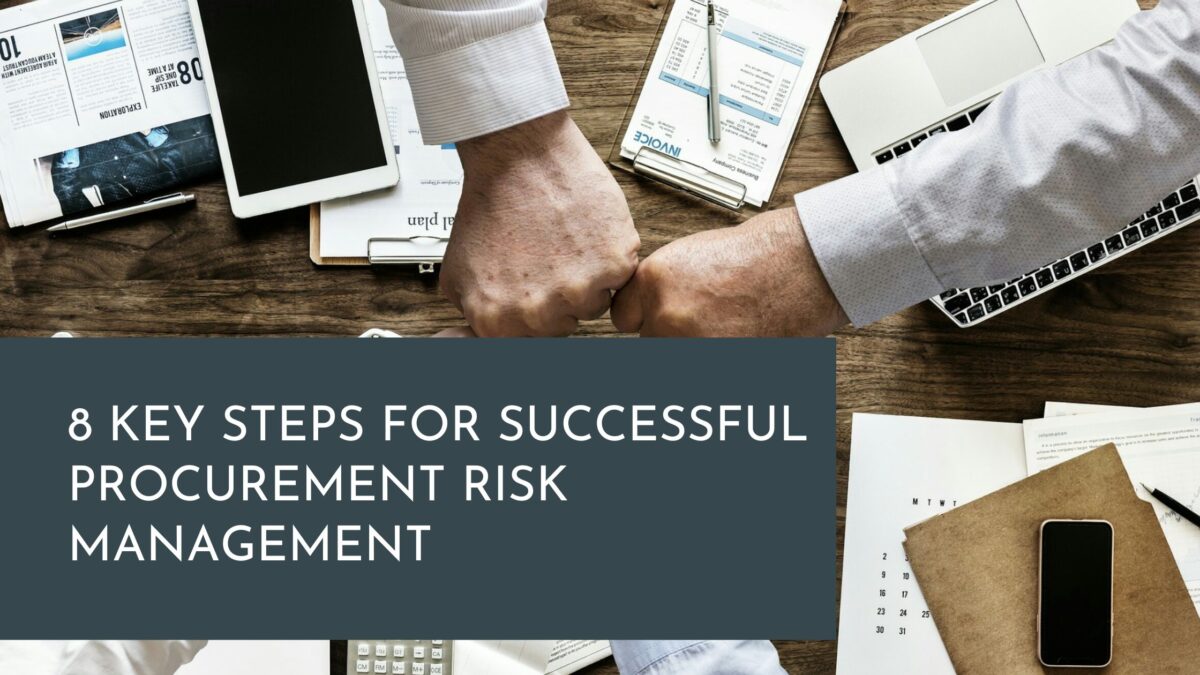8 Key Steps for Successful Procurement Risk Management

Introduction
In the world of business, effective procurement risk management is crucial for ensuring the smooth functioning of organizations. Procurement risk refers to the potential hazards and uncertainties associated with the process of acquiring goods and services from external suppliers. Failing to address these risks can lead to various negative consequences such as project delays, cost overruns, and reputational damage. To mitigate these risks, it is essential to follow a structured approach. In this article, we will explore the eight key steps for successful procurement risk management.
Conduct a Comprehensive Risk Assessment
The first step in successful procurement risk management is conducting a thorough risk assessment. This involves identifying and evaluating potential risks that may arise during the procurement process. These risks can include supplier non-performance, delivery delays, quality issues, and legal or regulatory compliance concerns. By understanding and assessing these risks upfront, organizations can develop appropriate mitigation strategies and contingency plans.
Establish Clear Procurement Objectives
To effectively manage procurement risks, it is important to establish clear objectives for each procurement activity. These objectives should align with the overall business goals and consider factors such as cost, quality, timeliness, and supplier performance. By defining specific and measurable objectives, organizations can better evaluate supplier proposals and make informed decisions that mitigate potential risks.
Implement Robust Supplier Selection Processes
Choosing the right suppliers is critical for minimizing procurement risks. Organizations should develop robust supplier selection processes that evaluate potential suppliers based on criteria such as financial stability, track record, technical capabilities, and adherence to ethical standards. By conducting due diligence and selecting reliable suppliers, organizations can reduce the likelihood of disruptions and ensure a smooth procurement process.
Establish Effective Contractual Agreements
Clear and well-defined contractual agreements are essential for managing procurement risks. Contracts should include detailed specifications, performance indicators, delivery timelines, payment terms, and dispute-resolution mechanisms. A carefully crafted contract helps establish expectations and responsibilities, reducing the likelihood of misunderstandings and disputes. It is also important to regularly review and update contracts to reflect changing circumstances and minimize potential risks.
Monitor Supplier Performance
Continuously monitoring supplier performance is a crucial step in procurement risk management. Organizations should establish performance metrics and regularly assess supplier compliance with contractual obligations. By closely monitoring supplier performance, organizations can detect early warning signs of potential risks and take corrective actions promptly. This proactive approach enables organizations to address issues before they escalate and impact the overall procurement process.
Maintain Effective Communication Channels
Open and transparent communication is vital for successful procurement risk management. Establishing effective communication channels with suppliers promotes collaboration, enables early identification of risks, and facilitates timely resolution of issues. Regular meetings, progress updates, and feedback sessions help build strong relationships and ensure all parties are aligned toward achieving common objectives.
Implement Risk Mitigation Strategies
No matter how well the procurement process is managed, some risks may still materialize. It is crucial to have well-defined risk mitigation strategies in place to minimize the impact of these risks. This may include having alternative suppliers, developing contingency plans, or implementing risk transfer mechanisms such as insurance coverage. By proactively preparing for potential risks, organizations can navigate challenges more effectively and safeguard their procurement activities.
The key steps for successful procurement risk management include conducting a comprehensive risk assessment, establishing clear procurement objectives, implementing robust supplier selection processes, establishing effective contractual agreements, monitoring supplier performance, maintaining effective communication channels, implementing risk mitigation strategies, and continuously improving procurement processes.
Continuously Improve Procurement Processes
Successful procurement risk management is an ongoing process that requires continuous improvement. Organizations should regularly review and evaluate their procurement processes, identify areas for enhancement, and implement necessary changes. By learning from past experiences and staying updated with industry best practices, organizations can strengthen their procurement capabilities and mitigate risks
Conclusion
Successful procurement risk management is essential for organizations to minimize potential disruptions, optimize cost efficiency, and achieve their procurement objectives. By following the eight key steps outlined in this article, organizations can proactively identify, assess, and mitigate risks associated with the procurement process. By implementing robust risk management strategies, organizations can enhance their ability to navigate challenges, protect their interests, and maintain successful procurement operations.
Remember, effective procurement risk management requires ongoing evaluation, improvement, and adaptation to changing circumstances. By embracing a proactive approach, organizations can strengthen their procurement practices and ensure long-term success.
Author: Axiswebart team has 5+ years of experience in writing content on Project Management topics and along with different publications. Also, they are delivering good write-ups on various other projects too.









